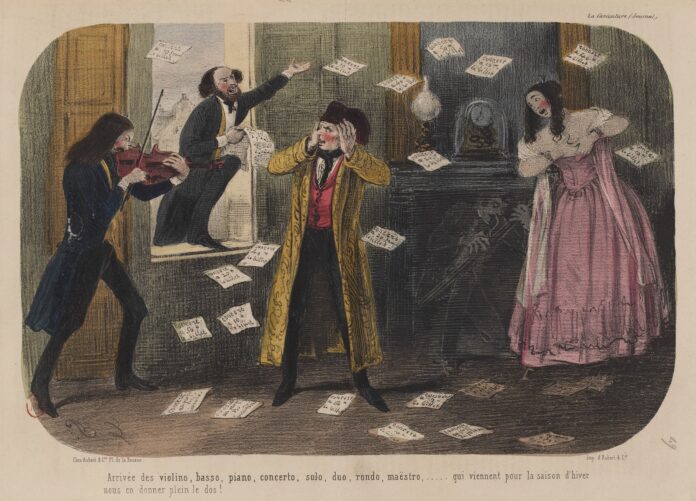
Organized by
Centro Studi Opera Omnia Luigi Boccherini
Palazzetto Bru Zane – Centre de musique romantique française
———–
Pisogne (BS), Sala De Lisi
Via Cavour 1
17-19 October 2025
CALL FOR PAPERS
The Centro Studi Opera Omnia Luigi Boccherini and the Palazzetto Bru Zane – Centre de musique romantique française are pleased to invite submissions of proposals for the symposium «The Early Romantic Solo Concerto», to be held in Pisogne (BS), Sala De Lisi, from Friday 17 until Sunday 19 October 2025.
The period from the mid-eighteenth to the early-nineteenth century was full of fundamental changes in European life. The composer, no longer bound to the service of a court or a patron, sought to be fully integrated into the music market. The market for printed music and the evolution of musical instruments transformed both the role of the composer and the image of the performing musician to a considerable extent.
Music went from being an amusement for the upper class to becoming an entertainment of the middle class, who advocated music that favoured participatory experience and thus created a social role for music that was different from that employed by the aristocracy. Composers responded to the needs of the middle class by creating a musical style that better suited the musical ideals of the bourgeoisie itself (see Sumner Lott 2010).
In this regard, the phenomenon of virtuosity that developed in this period (not only in music but also in other spheres of work such as chess, gastronomy, criminology or the growing automation industry, just to name a few) perfectly met the needs of a bourgeoisie that believed that life could be manageable and modifiable and that this was not already predetermined and decided.
In this sense, the virtuoso — who exhibits his or her talent in front of an audience, who possesses as his or her main endowment a high degree of technical skill and who grows in reputation and fortune, primarily through the exhibition of his or her skill (Metzner 1998) — became a projection, a means used to reclaim a kind of Kleinian position in the wider world, to analyse and, if necessary, to amend one’s own image: the artist became a means to organise a rite, to identify with a mythical hero and so to achieve a social status.
In the midst of this industrial and social transformation, the virtuoso, and consequently the solo concerto, became a pivotal and decisive feature of musical culture of the first half of the nineteenth century, being an ideal genre for expressing the ambitions of early Romanticism by exploiting the possibilities inherent in the juxtaposition of solo and orchestral forces. The concerto as a genre became the centrepiece of public concerts more than ever before: it created profit for the composer, gave fame to the performer, and appealed to the listener’s taste.
In this context, the production of solo concertos between the last decade of the eighteenth century and the first thirty years of then nineteenth century was substantial both in number and in the instruments for which they were composed; is it possible, therefore, to identify a common aesthetic and stylistic path in that production that could be counted under the umbrella of ‘early romantic’?
The programme committee encourages submissions within the following general areas:
- Concerto and performing venues
- Solo concerto: professionalism vs amateurism
- Studies focusing on careers, repertoire and reception
- Stylistic topoi and Musical Form
- New sonorities and instrument development
- Performing traditions in the history of the solo concerto
- Industrial and Consumer Revolution
- Music Publishing and Markets
- Circulation and dissemination
- Women composers and musicians
- The classical model of concerto form
- New approaches to the genre
- Cadenza and virtuosity
Programme Committee:
- Roberto Illiano (Centro Studi Opera Omnia Luigi Boccherini)
- Étienne Jardin (Palazzetto Bru Zane – Centre de musique romantique française)
- Massimiliano Locanto (Università degli Studi di Salerno)
- Fulvia Morabito (Centro Studi Opera Omnia Luigi Boccherini)
- Massimiliano Sala (Centro Studi Opera Omnia Luigi Boccherini)
Keynote Speaker:
- Simon P. Keefe (University of Sheffield)
- John D. Wilson (Universität Wien)
The official languages of the conference are English, French and Italian. Papers selected at the conference will be published in a miscellaneous volume.
Papers are limited to twenty minutes in length, allowing time for questions and discussion. Please submit an abstract of no more than 500 words and one page of biographical information.
All proposals should be submitted by email no later than ***23 March 2025*** to <conferences@luigiboccherini.org>. With your proposal, please include your name, contact details (postal address, e-mail and telephone number) and (if applicable) your affiliation.
The committee will make its final decision on the abstracts by April 2025, and contributors will be informed immediately thereafter. Further information about the programme and registration will be announced after that date.
For any additional information, please contact:
Dr. Massimiliano Sala



